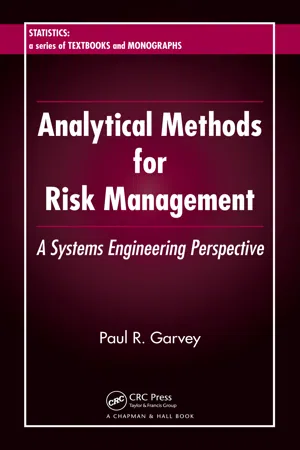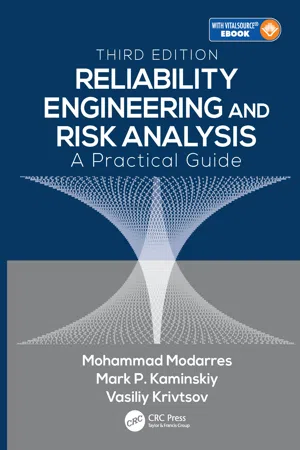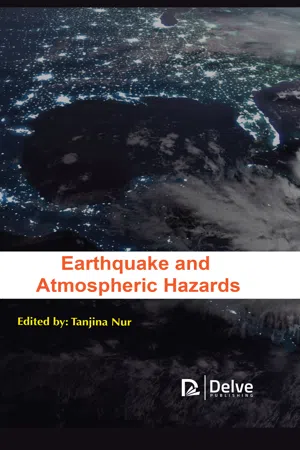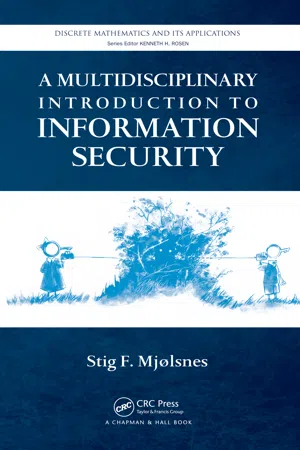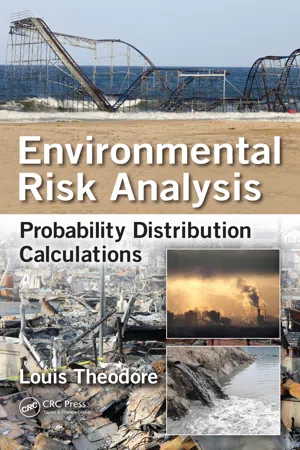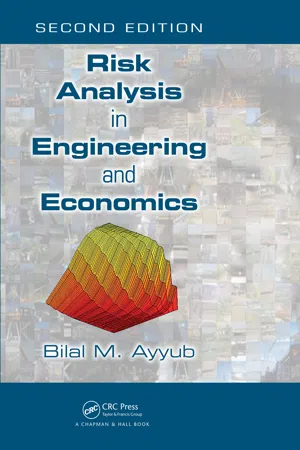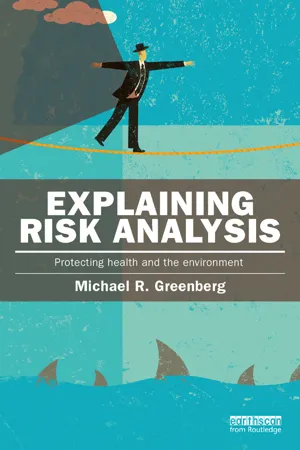Technology & Engineering
Risk Analysis
Risk analysis involves identifying, assessing, and prioritizing potential risks to a project, process, or system. It aims to understand the likelihood and impact of these risks and develop strategies to mitigate or manage them effectively. In technology and engineering, risk analysis is crucial for ensuring the safety, reliability, and success of complex systems and innovations.
Written by Perlego with AI-assistance
Related key terms
1 of 5
11 Key excerpts on "Risk Analysis"
- eBook - PDF
Socio-Technical Networks
Science and Engineering Design
- Fei Hu, Ali Mostashari, Jiang Xie, Fei Hu, Ali Mostashari, Jiang Xie(Authors)
- 2010(Publication Date)
- CRC Press(Publisher)
245 References ........................................................................................................ 246 230 ◾ Jonathan Scott Corley and Fei Hu © 2011 by Taylor & Francis Group, LLC improved by identifying the points of failure through application of various condi-tions of threat. Risk Analysis is a widely studied topic. In order to assess risk, it must first be defined. Risk is generally defined as the combination of the occurrence probability of damage and its gravity. Likewise, risk assessment is defined as the series of logical steps used to systematically examine the risks associated with an operational system [15]. But the difficulty in determining or defining which steps should be taken to analyze the system increases as the complexity of the system increases. This is the case for applying Risk Analysis to sociotechnical systems, where this system is defined as one in which influential interactions occur between humans and some organizational infrastructure. Sociotechnical systems are inherently multi-dimensional and highly complex. A means of defining the method for performing Risk Analysis to a given sociotechnical system is not necessarily applicable to other systems. Each application is typically unique and highly dependent on the domain of interest. Different studies addressing the difficulty of applying Risk Analysis to a socio-technical system are summarized in this chapter. Each describes the complexities that arise in accurately representing the system of interest, as well as, consideration of identifying all contributing factors. 9.2 Bayesian Belief Network Approach for Risk Analysis [5] It is widely accepted that the human element plays a major role in most accidents involving modern ships. The Transportation Safety Board of Canada (TSB) [2] concluded that 74% of accidents at sea are attributed to human error whereas only 1% is attributed to technical failures. The chart in Figure 9.1 displays the results of these statistics. - eBook - PDF
Analytical Methods for Risk Management
A Systems Engineering Perspective
- Paul R. Garvey(Author)
- 2008(Publication Date)
- CRC Press(Publisher)
2 Determine technical and performance risks related to engineering and manufacturing processes. Identify those processes that are planned or needed to design, develop, produce, support, and retire the system. Compare these processes with industry best practices and identify variances or new, untried, processes. These variances or untried processes are sources of risk. The contractor should review the processes to be used by its subcontractors to ensure they are consistent with best industry practices. 3 Determine technical and performance risks associated with the engineering system project and all its subsystems (e.g., a communications subsystem) to include the following critical risk areas: design and engineering, technology, logistics, supportability, concurrency, and manufacturing. 4 Ensure cost-schedule objectives are realistic and cost-schedule estimates reflect true program uncertainties; identify whether cost-schedule-performance options exist that offer less risk but still meet user needs; work to baseline requirements and that users/stakeholders have been engaged; ensure funding profiles match acquisition strategy (or planning) across annual budget cycles. 5 All identified risks are documented in a risk management database, with a statement of the risk and a description of the conditions or root cause(s) generating the concern and the context of the risk. Mathematically, a risk event is equivalent to a probability event. Formally, 0 < P ( A | B ) = α < 1 where α is the probability risk event A occurs given the conditioning event B (the root cause event) has occurred. 112 Analytical Topics in Engineering Risk Management THEN these are the consequences IF this Risk Event Occurs Condition Root Cause The Region Bounded by this Space is Prob( A | B ) e.g., Event B e.g., Event A Condition Present 1 Risk Event 11 Subsystem will not be fully tested when integrated into the system for full-up system-level testing. - eBook - PDF
Reliability Engineering and Risk Analysis
A Practical Guide, Third Edition
- Mohammad Modarres, Mark P. Kaminskiy, Vasiliy Krivtsov(Authors)
- 2016(Publication Date)
- CRC Press(Publisher)
427 8 Risk Analysis Risk Analysis has three elements: risk assessment, risk management, and risk communication. There are many interactions and overlaps between these three main elements of Risk Analysis. The first element of Risk Analysis is assessment: the process through which the chance or frequency of a loss due to an item’s failure and the magnitude of the loss (consequence) is measured. Risk management is the process through which the potential (likelihood or frequency) magnitude and contributors to risk (loss) are evaluated, minimized, and controlled. Risk communication is the process through which information about the nature of risk (loss) and consequences, the risk-assessment approach, and the risk-management options are exchanged and discussed between the decision makers and other stakeholders. Risk Analysis measures the potential and magnitude of any loss from or to a system. If there are adequate historical data on such losses, the Risk Analysis can be directly measured from the statistics of the actual loss. This approach is often used for cases in which data on such losses are readily avail-able. For example, ample field data are usually available in car accidents, cancer risk, or the frequency and magnitude of certain storms. When there is no event on the actual losses, the loss is modeled using Risk Analysis methods. In this analysis, the potential loss (i.e., the risk) is predicted. There are not many cases, especially for complex engineering systems, for which data on losses are available. Therefore, often we must model and predict the risk. Risk analysts attempt to measure the magnitude of a loss and the consequences associated with complex systems, including evaluation and firming up policies. Generally, there are three types of Risk Analysis: quantitative, qualitative, and a mix of the two. Each of these widely used methods has different purposes, strengths, and weaknesses. - eBook - PDF
- Tanjina Nur(Author)
- 2019(Publication Date)
- Delve Publishing(Publisher)
7.2. IMPORTANCE OF Risk Analysis Risk Analysis plays an important role in making some appropriate plans regarding projects, which can be used to estimate and nullify the problems. It can be used to identify whether it is feasible to go on with this project. It helps to prepare for the extreme situation such as failure in technology, theft, natural disaster or any other environmental changes. It helps in improving security and tries to manage various risk at workplace. It can also be used unforeseen changes in environment. Risk management approach can also be used to resolve environmental issues that are being used at all the levels of policy and regulation. It can be used in designing regulations to find out those risks that are accepted by the society and act as a basis for other environmental standards. It provides the site-specific decision. It helps in prioritizing the risk to environment and comparing the risk in order to enable comparison to be made to control various risk or allow risk substitution decision to be made. With the help of this approach, a lot of development has been undertaken within an industry. It is used in an industry to compile with law, to produce safe products, to make appropriate plans relate to finance, to have site-specific decision making, to priories and evaluate all the measures to reduce risk. Earthquake and Atmospheric Hazards 188 7.3. FACTORS INFLUENCING Risk Analysis Risk Analysis provides information on potential health or environmental risk. There are various factors by which the Risk Analysis is influenced. They are as follow: • Scientific factor – As a scientific factor the Risk Analysis include information drawn from toxicology, chemistry, statistics, ecology, epidemiology, etc.; • Economic factor – As an economic factor Risk Analysis helps to guide the manger regarding cost benefit analysis. - eBook - ePub
- Maria Chiara Leva, Tom Kontogiannis, Marko Gerbec, Olga Aneziris, Maria Chiara Leva, Tom Kontogiannis, Marko Gerbec, Olga Aneziris(Authors)
- 2019(Publication Date)
- Routledge(Publisher)
2 Understanding hazards and risksPassage contains an image
From the basics to new frontiers Micaela Demichela and Gabriele Baldissone3 Process risk assessmentIntroduction
Process risk assessment is nowadays a mature discipline that is based on consolidated techniques and tools for each phase of its cycle. The definition of “risk” and the methodologies falling under the acronym PRA – Probabilistic Risk Assessment – have arisen from the nuclear domain and laid the foundations of technological risk evaluation (Rasmussen 1975).Technological risk refers to the undesired consequence of a particular hazardous activity in relation to its likelihood of occurrence . This clearly means that the risk (R ) can be seen as the product of two parameters: F , the expected probability that a hazardous event could occur within a given time interval; and M , the severity of the consequences ensued (Magnitude).From the Rasmussen’s Report the logical link between the two is set to:R = F · MThis simple definition of technological risk allows safety analysts to assess risks and make comparisons between the foreseeable risks associated to a given process or plant or to examine whether risks fall within particular tolerability limits.Since process plants are usually complex socio-technical systems, the risk assessment process requires a procedure to control this complexity and to support risk-based decision making within the Total Safety Management framework (see Chapter 1 ).The risk assessment procedure
As discussed in Chapter 1 , standard ISO 31000:2009 defined a framework for risk assessment that is coherent with most process risk assessments from early days, although with some variations. According to Figure 3.1 - Stig F. Mjolsnes(Author)
- 2011(Publication Date)
- Chapman and Hall/CRC(Publisher)
• Alternatively, there are no vulnerabilities that can be exploited and the con-trols in place successfully prevent the hacker from penetrating the system. No adverse effects are experienced. 13.2.4 Risk Analysis, Risk Evaluation, and Risk Assessment The terms Risk Analysis, risk evaluation, and risk assessment also needs to be defined. The three terms and how they are related are visualized in Figure 13.2. All of these definitions are based on ISO/IEC 27001 [6] (which in turn is based on ISO/IEC Guide 73:2002 [3]): Risk Assessment 267 Risk Analysis is systematic use of information to identify sources and to estimate the risk. In this definition, the term source is used. This could cover both threat and incident as defined above. However, in practical terms, sources should be the relevant incidents that may occur. Estimate risk will usually mean that the probability of the unwanted events and the consequences are described or estimated qualitatively or quantitatively and combined. Since threats can be present constantly (as a condition), it is not always meaningful to talk about the probability of the presence of a threat, as opposed to the probability of something happening (an event). It can be assumed that hackers exist so it does not really make sense to ask what the probability of hackers existing is, but we may ask what the probability that hackers will attack a system is. In simple terms, Risk Analysis is about answering three questions: • What can happen (what are the events/incidents)? • What are the causes (and the probability) of this happening (what are the hazards or threats)? • What are the consequences if this happens? The next term that we need to define is risk evaluation : Risk evaluation is the process of comparing the estimated risk against given risk criteria to determine the significance of the risk.- eBook - PDF
Environmental Risk Analysis
Probability Distribution Calculations
- Louis Theodore(Author)
- 2015(Publication Date)
- CRC Press(Publisher)
Several of the terms contain the word risk . The so-called traditional definitions associated with these words or phrases are presented there. This section attempts to review not only the myriad of risk and risk-related terms but also some of the myriad of accompanying definitions of these terms that have been used in indus-try and have appeared in the literature. No attempt has been made to present this list in alphabetical order. Rather, this approach has attempted to provide the various terms in a logical, sequential order. 9 Introduction to Environmental Risk The four major risk terms include 1. Risk 2. Risk assessment 3. Risk Analysis 4. Risk management “Risk” was defined earlier as a measure of economic loss, human injury, or human health effect, and in terms of both the likelihood (probability) and the magnitude (consequences) associated with either a loss or injury. Although it is a quantifiable term, it has been misused by practitioners. “Risk assessment” involves the process of determining the events or problems that can produce a risk, the corresponding probabilities and consequences, and finally, the characterization of the risk. “Risk Analysis” employs the results of the aforementioned risk assessment and attempts to optimally use these results; in effect, it analyzes risk assessment information. Finally, “risk management” uses all the information provided by the risk assessment and Risk Analysis steps to reduce or eliminate the risk, select the optimum action(s), or evaluate the net benefits verses health/safety concerns. Note, however, that in line with its title, this book is primarily concerned with risk calculations from both a health and hazard perspective. - eBook - PDF
Further Developments in Operational Research
Frontiers of Operational Research and Applied Systems Analysis
- G. K. Rand, R. W. Eglese(Authors)
- 2014(Publication Date)
- Pergamon(Publisher)
Judgements must be made, in some cases based upon hard data, in others based on sound conventional guidelines. 9 In other cases creative innovation and well schooled intuition based upon a wide range of relevant experience must be used. Expertise involving an effective and efficient blend of all these aspects Risk Analysis 31 is not made less important by adopting Risk Analysis methods: it is simply made use of more effectively. Risk Analysis requires many forms of expertise. Economics, finance, environmental issues, contractual issues, etc., are clearly involved in most major projects. What is not always appreciated is that they may directly impact the way the design and planning is done, and they should be properly considered in a timely manner. Risk Analysis helps to provide this integration. Risk Analysis study team management Risk Analysis study team management requires special consideration. Like the model/method/ software aspects of Risk Analysis method design, it must be adapted to the circumstances. For example, one company uses an in-house Risk Analysis Group in an internal audit role most of the time. Analysts examine a project plan and cost estimates in detail over a period of six to eight weeks. Their work then provides useful immediate feedback to the project staff, but they report to the project manager and the head of the planning and costing function group. Other companies have used large teams over several months to perform a complete analysis, externally to the project team, and to make recommendations based upon fundamental judgements which go beyond the Risk Analysis itself. Other studies have involved only two or three professionals over an elapsed time of just a few weeks. Very different kinds and styles of management are clearly necessary for such diverse operations. - eBook - PDF
- Bilal M. Ayyub(Author)
- 2014(Publication Date)
- Chapman and Hall/CRC(Publisher)
Risk communication involves perceptions of risk and depends on the audience tar-geted; hence, it is classified into risk communication to the media, the public, and the engineering community. The various components of managing risk can be structured in the form of a process as shown in Figure 2.9 (ISO 2009a). The process emphasizes the importance of continual improvement in risk management in order to ensure success. 2.3.5 Risk Assessment Methodologies A risk assessment process should utilize experiences gathered from project personnel, other similar projects and data sources, previous risk assessment models, and other indus-tries and experts, in conjunction with analysis and damage evaluation using various pre-diction tools. A risk assessment process is commonly part of a risk-based or risk-informed methodology that should be constructed as a synergistic combination of decision mod-els, advanced probabilistic reliability analysis algorithms, failure consequence assess-ment methods, and conventional performance assessment methodologies that have been employed in a related industry for performance evaluation and management. The meth-odology should realistically account for the various sources and types of uncertainty involved in the decision-making process. In developing a Risk Analysis methodology, the following requirements should be treated as key guiding principles: • Analytic: The methodology must provide a system-based framework for assessing risk by decomposing it into its basic elements. It must enable a system-based frame-work for decomposition into its basic elements through a segregation process, and these elements are logically connected to enable aggregation. This requirement is called the principle of consistent segregation and aggregation . • Quantitative: Risk is expressed in meaningful and consistent units (e.g., dollars and fatalities) so as to provide a basis for performing trade-offs and benefit–cost analysis. - eBook - PDF
Systems Engineering for the Digital Age
Practitioner Perspectives
- Dinesh Verma, Dinesh C. Verma(Authors)
- 2023(Publication Date)
- Wiley(Publisher)
During this process, it is useful to review the project with respect to potential categories of risk. The SEI Taxonomy of Software Development Risks Kendall et al. (2007) is a useful aid for this purpose. Summary This chapter discussed approaches to managing risk during project development and sustainment with a particular focus on agile-based projects within large enterprise systems. Risk is generally defined as the measure of the potential inability to achieve overall program objectives within defined cost, schedule, and technical constraints. What is missing from this definition are risks associated with failing to identify and capture evolving user, system, and technical requirements, which are often driven by evolving end-user or marketplace demands. Ignoring these evolving needs introduces risks, meaning you may be developing an obsolete product or one that only par- tially meets end-user needs. This chapter focused on managing three types of risks to systems engineering and development: project development risk, technical risk, and obsolescence risk. References Agile Alliance (2023). Agile 101. https://www.agilealliance.org/agile101/. Corryton, TN: The Agile Alliance. Baldwin, C.Y. and Clark, K.B. (2000). Design Rules: Volume 1. The Power of Modularity. Cambridge, MA: MIT Press. Boehm, B. (1986). A spiral model of software development and enhancement. ACM SIGSOFT Software Engineering Notes 11 (4): 14–24. DAU (2003). Risk Management Guide for DoD Acquisition, 5e. Belvoir, VA, USA: Defense Acquisition University (DAU)/U.S. Department of Defense, Fifth Edition, Version 2. Managing Risk 470 Forsberg, K. and Mooz, H. (1994). The relationship of system engineering to the project cycle. Proceedings of the 12th INTERNET World Congress on Project Management, Oslo, Norway (9–11 June 1994). Kendall, R.P., Post, D.E., Carver, J.C. et al. (2007). A Proposed Taxonomy for Software Development Risks for High-Performance Computing (HPC) Scientific/Engineering Applications. - eBook - ePub
Explaining Risk Analysis
Protecting health and the environment
- Michael Greenberg, Michael R Greenberg(Authors)
- 2016(Publication Date)
- Routledge(Publisher)
This second step requires a commonly accepted language of key terms and concepts. The Society for Risk Analysis (SRA) (www.sra.org) has published several glossaries. One available through the website includes short definitions of more than 300 terms. The second produced by the SRA Committee on Foundations of Risk Analysis divides the glossary into “basic concepts,” “related concepts, methods, and procedures,” and “risk management actions.” It acknowledges that it is unrealistic to assume that there will be a single definition of these terms and concepts (Committee on Foundations 2015). The second glossary provides multiple definitions of the word risk and other terms, and I am a strong advocate of using it because of the depth it provides. I have collected more than 20 definitions of risk written by individuals with backgrounds in public health, engineering, economics and others. In this book, I use the following definition of risk developed by William Lowrance (1976), and arguably the most widely cited: Risk is a measure of the probability and severity of adverse events. In regard to the definition of Risk Analysis, as part of the celebration of the thirtieth year of the Society of Risk Analysis in the year 2010, a group of the editors of the society’s journal, Risk Analysis, An International Journal summarized major accomplishments (Greenberg et al. 2012)
Index pages curate the most relevant extracts from our library of academic textbooks. They’ve been created using an in-house natural language model (NLM), each adding context and meaning to key research topics.

